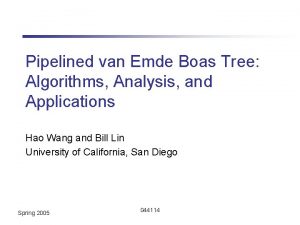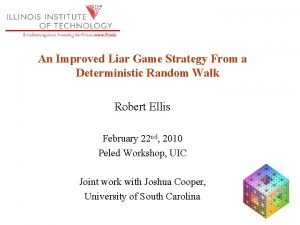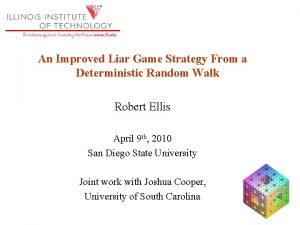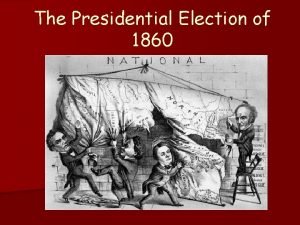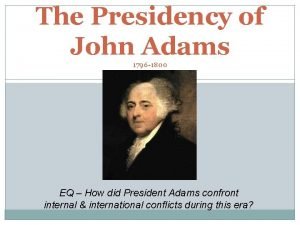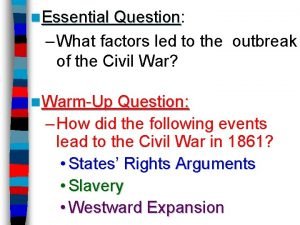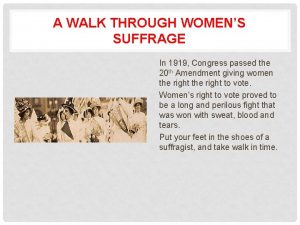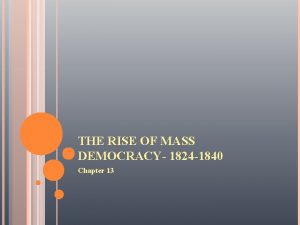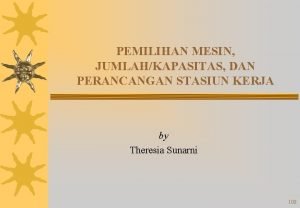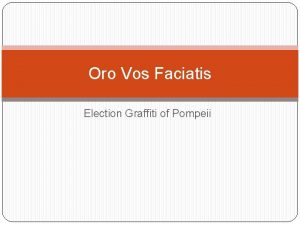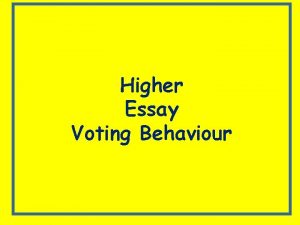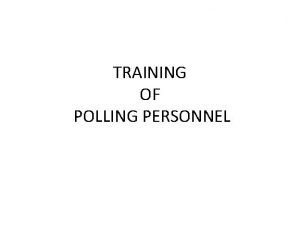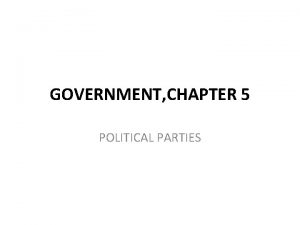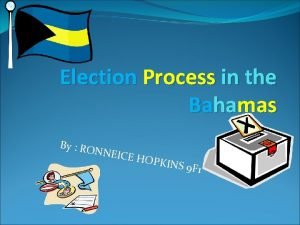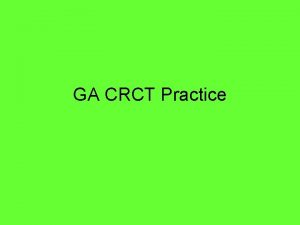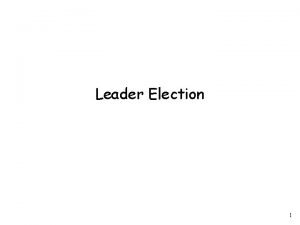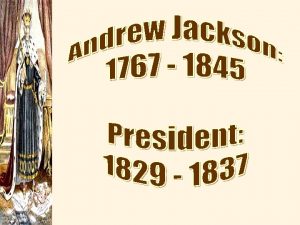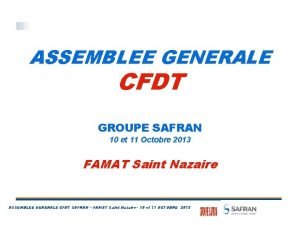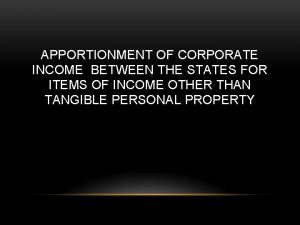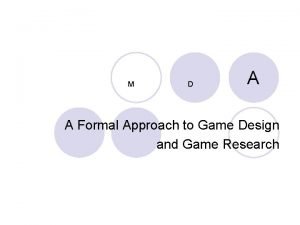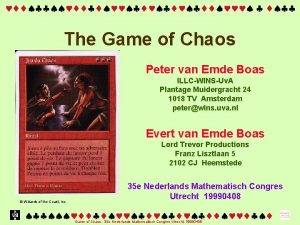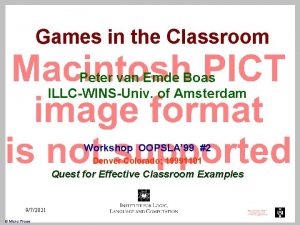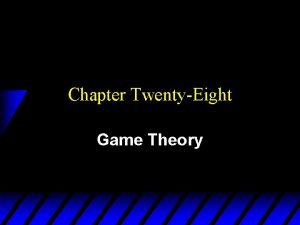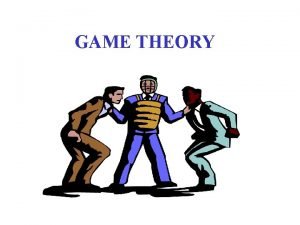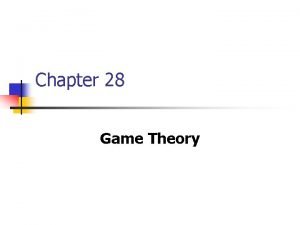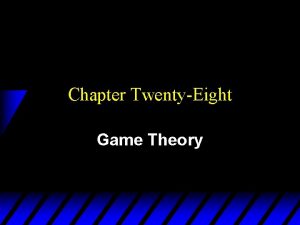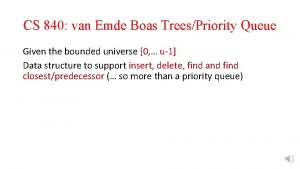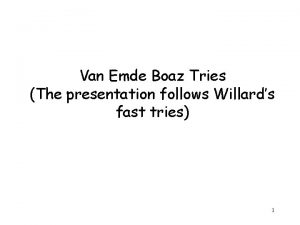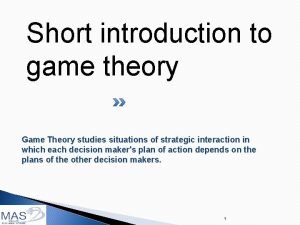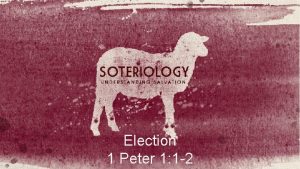INTRODUCTION GAME THEORY ELECTION SPECIAL Peter van Emde




































![Geometric Picture Normalized result: divide the collected weights W[i] by their sum; this Geometric Picture Normalized result: divide the collected weights W[i] by their sum; this](https://slidetodoc.com/presentation_image_h2/15c3c1328003faf5f2ed78080e51c3f2/image-37.jpg)













- Slides: 50

INTRODUCTION GAME THEORY ELECTION SPECIAL Peter van Emde Boas ILLC-FNWI-Uv. A Bronstee. com Software & Services B. V. 2009 See: http: //staff. science. uva. nl/~peter/teaching/igt 09. html Introduction Game Theory 2008 -09. Peter van Emde Boas

Is this a fair election system ? Introduction Game Theory 2008 -09. Peter van Emde Boas

Waterschappen are an ancient type of local Government responsible for water infrastructure: Dykes, pumps, windmills, canals, polders, …. Unique for the Netherlands Oldest democratic institution in the Netherlands (or the entire world ? ? ) Special about this year’s election: for the first time involvement of political parties Introduction Game Theory 2008 -09. Peter van Emde Boas

Is this a fair election system ? Voting by Mail Ballots exhibit a code which identifies the voter ! Data in possession of two private enterprises If these two collude ? ! Introduction Game Theory 2008 -09. Peter van Emde Boas

Consequences…. SEE YOU IN COURT !! Introduction Game Theory 2008 -09. Peter van Emde Boas

Chaotic Elections Donald G. Saari’s mathematical analysis explaining how positional voting systems can produce outrageously many different outcomes. Everybody can win, depending on the procedure used ! Introduction Game Theory 2008 -09. Peter van Emde Boas

The book and its Author © Peter van Emde Boas Donald G. Saari @ 37 th Dutch Math. Conference VUA, 20010419 Introduction Game Theory 2008 -09. Peter van Emde Boas

The problem with voting procedures Typically the wrong candidates get elected: Bush vs. Gore 2000 French presidential election 2002 Who of the prospective voters present today understands the intricacies of the Dutch Proportional Representation System ? Israel 1981: the week after the elections the results were every day different ! Introduction Game Theory 2008 -09. Peter van Emde Boas

Hear the Prophet The Jerusalem Post July 03 1981 Introduction Game Theory 2008 -09. Peter van Emde Boas

Election Pvd. A Chairman 20070924 © NRC Handelsblad & Pvd. A, Sep 25 2007 Transferable vote system: voters rank all candidates. Candidate with absolute majority is elected; Otherwise candidate with least votes is removed, and her votes are transferred to the next candidate who is still in the race. Introduction Game Theory 2008 -09. Peter van Emde Boas

Who is to Blame ? Voter incompetence ? Incompetence of Political Party System ? Obsolete / Unreliable Voting Equipment ? ? The Usual Suspects: the Capitalists, the Media, the Aliens, . . . The Voting System ? ? . . . Introduction Game Theory 2008 -09. Peter van Emde Boas

The Mathematics of Voting Procedures What is a voting procedure ? Aggregate individual preferences into a social one What are reasonable conditions for calling a voting procedure to be fair ? Various, like non triviality, Pareto, . . . Do fair voting procedures exist ? No: Arrow’s non-existence theorem. . . What is wrong with the procedures used in society ? Procedure determines winner, not the voters. . How bad can it be ? Much worse than you would believe Introduction Game Theory 2008 -09. Peter van Emde Boas

Voter’s Profile and procedure There are k candidates A, B, C, . . . H There are n voters 1, 2, . . , n each voter has a strict preference order for the candidates: V[i, 1] > V[i, 2] >. . V[i, k] These individual profiles must be aggregated into a (possibly non-strict) social order: W[1] W[2] . . W[k] Introduction Game Theory 2008 -09. Peter van Emde Boas

Fair Procedures What are fair procedures ? State conditions: Pareto: If all voters have identical preferences, this should be the aggregated result of the procedure Independence irrelevant Alternatives: the resulting position of A vs B only depends on the relative positions in the ballots assigned to A and B, but not on the positions of the remaining candidates. . Introduction Game Theory 2008 -09. Peter van Emde Boas

Example: Vote for one Plurality Count the number of voters having candidate X as their first preference: N[ X ] the score of X Order the candidates by decreasing scores: N[ W[1] ] N[ W[2] ] . . . N[ W[k] ] Ties are evidently possible Introduction Game Theory 2008 -09. Peter van Emde Boas

Independence Irrelevant Alternatives ( IIA ) Result of the ballot: A > B > C : 3 votes C > A > B : 2 votes B > A > C : 3 votes C > A > B : 2 votes For 1 Plurality yields A > C > B For 1 Plurality yields B > C > A Nobody changed his opinion on A vs C , yet in the aggregated result their position is reversed. . . For 1 Plurality doesn’t obey IIA Introduction Game Theory 2008 -09. Peter van Emde Boas

Arrow’s Result Voting procedures which aggregate arbitrary strict voter profiles into a (non-strict) total social order, and which do observe the Pareto property and IIA do exist. However Dictatorship is the only example. . Dictatorship: Select a single voter to become Dictator: his ranking becomes the Social one. . . So much for the dream of Democracy ; we will have to work with less ideal procedures. . . Introduction Game Theory 2008 -09. Peter van Emde Boas

Other Issues Proportional Representation issues: How to round fractions to integers in a fair way Creation of Districts: Voter power, Gerrymandering, . . . Condorcet winners; Lewis Carrol’s system, . . Focus topic in this Talk: Lack or relation between voter profile and result of the election for weighted majority systems. Introduction Game Theory 2008 -09. Peter van Emde Boas

GERRYMANDERING State with three districts; who will win ? Introduction Game Theory 2008 -09. Peter van Emde Boas

GERRYMANDERING State with three districts; who will win ? Reps: 3 , Dems : 0 Introduction Game Theory 2008 -09. Peter van Emde Boas

GERRYMANDERING State with three districts; who will win ? Reps: 2 , Dems : 1 Introduction Game Theory 2008 -09. Peter van Emde Boas

GERRYMANDERING State with three districts; who will win ? Reps: 2 , Dems : 1 Introduction Game Theory 2008 -09. Peter van Emde Boas

GERRYMANDERING State with three districts; who will win ? Reps: 1 , Dems : 2 Is it possible to have a 0 : 3 outcome ? Introduction Game Theory 2008 -09. Peter van Emde Boas

Example: Vote for one Plurality Count the number of voters having candidate X as their first preference: N[ X ] the score of X Order the candidates by decreasing scores: N[ W[1] ] N[ W[2] ] . . . N[ W[k] ] Ties are evidently possible Introduction Game Theory 2008 -09. Peter van Emde Boas

Vote for 2 plurality Count the number of voters having candidate X as their first preference: M 1[ X ] the first score of X Count the number of voters having candidate X as their second preference: M 2[ X ] the 2 nd score of X Combine scores : N[X] = M 1[X] + M 2[X] Order the candidates by decreasing scores: N[ W[1] ] N[ W[2] ] . . . N[ W[k] ] Ties remain possible Introduction Game Theory 2008 -09. Peter van Emde Boas

Anti-plurality - Blackball Each voter can name one candidate for being rejected Count the number of voters rejecting candidate X Order by increasing number of votes against This is equivalent to each voter voting for all candidates except one, and ordering by decreasing total scores Introduction Game Theory 2008 -09. Peter van Emde Boas

Hear the Prophet Introduction Game Theory 2008 -09. Peter van Emde Boas

Borda Count Each voter assignes k-1 points to his first preference, k-2 points to his second, etc. up to 1 points for the next to last preference. Each candidate collects the total of all points assigned Order by decreasing number of total points Introduction Game Theory 2008 -09. Peter van Emde Boas

General weighted vote for k Each voter assigns m 1 points to his first preference, m 2 points to his second, etc. up to mk-1 points for the next to last preference. Evidently one has m 1 m 2 . . . mk-1 Each candidate collects the total of all points assigned Order by decreasing number of total points Introduction Game Theory 2008 -09. Peter van Emde Boas

Comparing these systems Vote for one plurality : m 1 = 1 , m 2 =. . . = mk-1 = 0 Vote for two plurality : m 1 = m 2 = 1 , m 3 =. . . mk-1 = 0 Anti-plurality: m 1 = m 2 =. . = mk-1 = 1 Borda Count: m 1 = k-1 , m 2 = k-2 , . . , mk-1 = 1 In approval voting, the voters have also the freedom to select how many candidates they will assign points to. Introduction Game Theory 2008 -09. Peter van Emde Boas

Invariance Note that we always implicitly assumed that the least preferred candidate collects no points at all: mk = 0 The following operations leave the result invariant: add a constant c to all mj scale all mj by a factor s > 0 Hence WLOG: m 1 = 1 m 2 = s m 3 = t. . mk = 0 Introduction Game Theory 2008 -09. Peter van Emde Boas

Example: Result of the ballot: Result of the election: A A B B C C for 1 majority: A > C > B for 2 majority: B > C > A Borda Count: C > B > A. . > > > B C A B > > > C B C A B A : : : 3 2 0 4 votes votes What else could we construct on the base of this ballot ? ? ? !! Introduction Game Theory 2008 -09. Peter van Emde Boas

Another example Result of the election: Result of the ballot: A A C D > > B D B B > > C C D C > > D B A A : : 2 2 2 3 votes for 1 majority: A wins for 2 majority: B wins for 3 majority: C wins Borda count: D wins. . What further evidence do we need ? ? ? !! A similar example for 5 candidates ? Saari gives one…. Introduction Game Theory 2008 -09. Peter van Emde Boas

Saari’s Result For every k > 2 one can construct voter profiles for a k candidate election such that the number of strict rankings obtainable by generalized weighted vote for k procedures equals k ! - (k-1) ! This is a tight upper bound ; if one also considers non-strict obtainable rankings the number is even larger. Introduction Game Theory 2008 -09. Peter van Emde Boas

Number of possible rankings k number 2 3 4 5 6 7 8 9 10 11 12 13 14 15 322 560 3 265 920 36 288 000 439 084 800 5 748 019 200 80 951 270 400 1 219 496 076 800 1 4 18 96 600 4320 35 280 Introduction Game Theory 2008 -09. Peter van Emde Boas

More Bad News For k > 3 there are profiles such that (depending on the procedure used) any candidate can be ranked at any position In an appropriate probabilistic model, such profiles have a reasonable chance of occurring. So it is the procedure which matters, not what the voters are doing. . . Introduction Game Theory 2008 -09. Peter van Emde Boas
![Geometric Picture Normalized result divide the collected weights Wi by their sum this Geometric Picture Normalized result: divide the collected weights W[i] by their sum; this](https://slidetodoc.com/presentation_image_h2/15c3c1328003faf5f2ed78080e51c3f2/image-37.jpg)
Geometric Picture Normalized result: divide the collected weights W[i] by their sum; this yields a k-vector with entries in [0, 1] such that the sum equals 1 : a point in the k-1 simplex embedded in E(k) in the standard way. In this simplex the k! possible rankings correspond to sub-simplices in the subdivision generated by the k(k-1)/2 hyperspaces xi = xj These hyperspaces represent rankings with ties. Introduction Game Theory 2008 -09. Peter van Emde Boas

Geometric Picture: k = 3 C C>A>B C>B>A B>C>A A>C>B B A A>B>C A=B B>A>C Introduction Game Theory 2008 -09. Peter van Emde Boas

A Voter Profile C C>A>B C>B>A 0 A>C>B 4 B>C>A 2 2 3 0 B A A>B>C A=B B>A>C Introduction Game Theory 2008 -09. Peter van Emde Boas

Scores for this profile C: 4 + 4. s C>A>B C>B>A 0 A>C>B 4 B>C>A 2 2 3 0 B: 2 + 7. s A: 5 + 0. s A>B>C A=B B>A>C Introduction Game Theory 2008 -09. Peter van Emde Boas

A simple computation The scores obtained in the previous picture are not normalized: Q(s) : = ( 5 + 0. s , 2 + 7. s , 4 + 4. s ) After normalization: q(s) : = 1/( 11(1+s)). ( 5 + 0. s , 2 + 7. s , 4 + 4. s ) = (1 – 2 t) ( 5/11, 2/11, 4/11 ) + 2 t ( 5/22, 9/22, 8/22 ) where t = s/(1+s) E. G. , s = 1/ 2 gives 2 t = 2/3 Introduction Game Theory 2008 -09. Peter van Emde Boas

A Convex combination of special results ! Let t = s/(1+s) : s [0, 1] gives 2 t [0, 1] q(s) : = 1/( 11(1+s)). ( 5 + 0. s , 2 + 7. s , 4 + 4. s ) = (1 – 2 t) ( 5/11, 2/11, 4/11 ) + 2 t ( 5/22, 9/22, 8/22 ) Normalized vote for 1 plurality result Normalized vote for 2 plurality result Introduction Game Theory 2008 -09. Peter van Emde Boas

Procedure Line (1 – 2 t) ( 5/11, 2/11, 4/11 ) + 2 t ( 5/22, 9/22, 8/22 ) C C>A>B C>B>A B>C>A A>C>B Borda count B A A>B>C A=B B>A>C Introduction Game Theory 2008 -09. Peter van Emde Boas

Procedure Line The general picture for k = 3: Given a voter profile determine the normalized results under the simple plurality and the antiplurality system (vote for 1 and vote for 2 ) All convex combinations of these two points are obtained for a suitable choice of s Arrange it for this line to hit as many cells as possible ! Introduction Game Theory 2008 -09. Peter van Emde Boas

Constraints Not all lines in this triangle are possible: The anti-plurality scores are in a sub-triangle (nobody scores more than half of the votes cast) Also each voter obtains at least as many votes under anti-plurality as under plurality; These are the only constraints The rest is combinatorics Introduction Game Theory 2008 -09. Peter van Emde Boas

Constraints plurality C anti-plurality C>A>B C>B>A B>C>A A>C>B Borda count B A A>B>C A=B B>A>C Introduction Game Theory 2008 -09. Peter van Emde Boas

The picture for k > 3 The k-1 simplex is embedded in E(k) The special scores are those of vote for j plurality j = 1, . . . , k-1 These points span a k-2 simplex Constraints are more complex Try to hit as many cells as possible See Saari’s book for a 2 -dim representation for k = 4 Introduction Game Theory 2008 -09. Peter van Emde Boas

The k=4 case Interior of the 3 -simplex is projected on the faces the center (1/4, 1/4) can’t be represented Introduction Game Theory 2008 -09. Peter van Emde Boas

Approval Voting With Approval Voting each voter is free to choose the number of candidates ranked. The resulting feasible region of scores now becomes the image of a k-cube under a linear map in the simplex of normalized outcomes Even far more cells can be hit by this image ! Introduction Game Theory 2008 -09. Peter van Emde Boas

Morale Perfect Voting systems don’t exist Advocates for weighted plurality systems, Beware. . . You will be blamed for the result ! There is more bad news in the sequel of the book: Iterative voting procedures, run-offs, strategic voting, . . . Know and Understand the system used when voting ! CHAOS RULES !! Introduction Game Theory 2008 -09. Peter van Emde Boas
 Van emde boas tree
Van emde boas tree Van emde boas trees
Van emde boas trees The pirate game
The pirate game Game lab game theory
Game lab game theory Liar game game theory
Liar game game theory Liar game game theory
Liar game game theory Game theory and graph theory
Game theory and graph theory Peter elbow believing game summary
Peter elbow believing game summary Cobra election form sample
Cobra election form sample Brainpop political parties
Brainpop political parties Party platform definition
Party platform definition What problems did this election underscore adams
What problems did this election underscore adams The election of 1800 showed that
The election of 1800 showed that Lincolns election date
Lincolns election date Abraham lincoln's election
Abraham lincoln's election Lincolns election
Lincolns election British election study
British election study Kansas nebraska act
Kansas nebraska act Election day political cartoon
Election day political cartoon 1796 election
1796 election Maysville veto
Maysville veto 1932 presidential election
1932 presidential election 1932 presidential election
1932 presidential election Election machine
Election machine Vos graffiti
Vos graffiti Compulsory voting essay
Compulsory voting essay Duties of polling officer in election 2014
Duties of polling officer in election 2014 Thomas county election results
Thomas county election results Election duty certificate for teachers
Election duty certificate for teachers Economic protest parties definition
Economic protest parties definition George caleb bingham the county election
George caleb bingham the county election The election process in the bahamas
The election process in the bahamas 1960 election
1960 election Election of 1860 pie chart
Election of 1860 pie chart Which statement describes a failure in mohandas
Which statement describes a failure in mohandas Fdr election map
Fdr election map Clarity election night reporting
Clarity election night reporting Martin van buren political party
Martin van buren political party State election commission rajasthan
State election commission rajasthan Hume foreclosures
Hume foreclosures Leader election problem
Leader election problem Xxxx20
Xxxx20 Was andrew jackson a president
Was andrew jackson a president Eci dashboard
Eci dashboard Election of 1896
Election of 1896 Dcrc full form in election
Dcrc full form in election Turbomeca tarnos recrutement
Turbomeca tarnos recrutement Arizona multistate service provider election
Arizona multistate service provider election The farming game board game
The farming game board game A formal approach to game design and game research
A formal approach to game design and game research Esther earl and augustus waters
Esther earl and augustus waters
